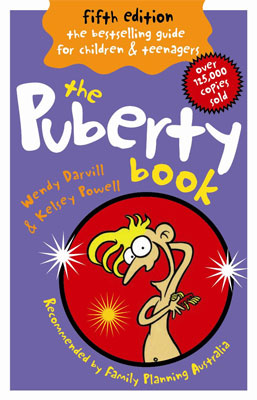The Puberty Book

Puberty Book
With all the latest information, this new fifth edition of The Puberty Book answers all of those direct (pre) teenage questions:
What's a wet dream?
How do you ask a girl on a date?
How are sperm made?
After sex do you get sick?
When should you start shaving your legs?
With simple language and honest answers, the authors discuss the changes that happen at puberty - sex and sexuality, health, relationships, pregnancy and birth. This new edition includes a new chapter on sexual health issues and is recommended by Family Planning Australia. The only book on the market written by Australian health experts, this is a one-stop shop for all questions about puberty for boys and girls.
Wendy Darvill and Kelsey Powell were actively involved in sexuality education in Australian primary and secondary schools and with community organisations for many years. Their bestselling book was inspired by their work with real kids, real parents in real situations. Kelsey recently retired as Chief Executive Officer, Family Planning Queensland. In addition to her wide ranging nursing qualifications and a Bachelor of Education Studies, Kelsey has extensive experience in international development work and its management and was Manager of Sexual Health and Family Planning Australia's International Program. She has been particularly involved in training and education in the South Pacific. Kelsey is currently an Assistant Professor at Bond University Medical School.
Puberty Book
Hachette
Authors: Wendy Darvill and Kelsey Powell
ISBN: 9780733626395
Price: $24.99
Interview with Kelsey Powell
What originally inspired you and Wendy to write the Puberty Book?
Kelsey Powell: Wendy and I were working as educators with Family Planning Queensland (FPQ,) and in that role talked to many parents who wanted good resources to help them to talk to their children about sex. We felt there were books for very young children about how babies are 'made' and some books for older children. However, the books for older children tended to target older teenagers and gave information more appropriate to young people who may already be sexually active. We felt there was a gap in the market for the children in between; those who were approaching puberty or just experiencing puberty
We know that sexuality education is more effective if people receive it early, well before they become sexually active, so we wrote this book targeting that age group.
Kelsey Powell: I have included information about the new immunization, Gardasil. This is now available to protect girls from some infections that may cause cervical cancer. In Australia most girls have this immunisation at school when they are 12 or 13 years old.
I have added more information on safe use of the internet and other technologies, such as social networking sites, use of mobile phones and texting in particular. I have included more information about cyber bullying as this has become more of an issue for young people today. I have tried to stress the negative impact that cyber bullying can have on a person, and talked about what young people could do if they feel they, or any of their friends are being bullied.
I have also added another method to the list of contraceptives as a new one, the vaginal ring, has been made available in Australia since the last edition.
At what age do you suggest a parent gives this book to their child(ren)?
Kelsey Powell: The book is written for young people as they approach puberty or are experiencing puberty. Depending in their reading level, the book is suitable for children from about nine to 13 or so.
Originally, what research did you do to know what puberty questions to cover in this book?
Kelsey Powell: All the questions in the book are questions that children have actually asked us or other sexuality educators at FPQ.
Over the years we worked at FPQ, we talked to thousands of children, as well as many parents and teachers. I always found, given a comfortable and non threatening environment, children were very interested, and asked thoughtful and intelligent questions.
Can you explain how the book is present and how this appeals to pre-teens and teenagers?
Kelsey Powell: I think the what most appeals to young people is the question and answer format. As I have said all the questions are ones that children have actually asked. We did not make any of them up, and I think young people identify with the questions. These are questions they would ask themselves. I also like to think that children appreciate how the questions are answered, in a factual and positive way. Our approach from the start was for the book to present growing up, puberty and sexuality in a healthy and positive way.
We continually stressed that the physical and emotional changes that happen at puberty are normal, and everyone goes through puberty. They are not alone.
I also think the cartoons and drawings add to the positive feel that we wanted the book to have.
MORE





